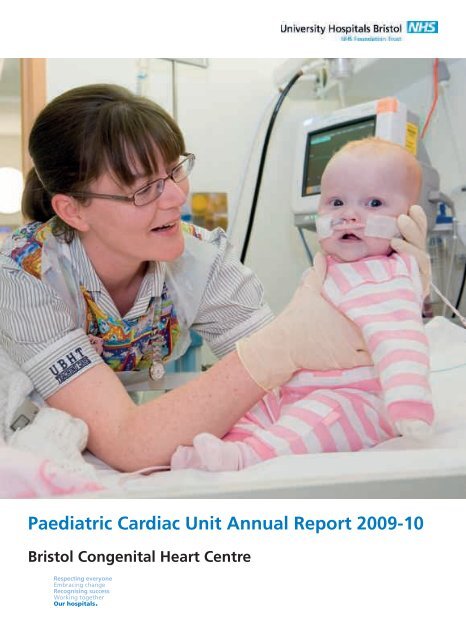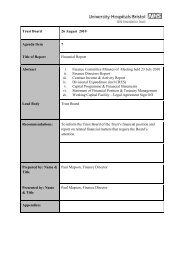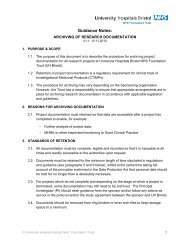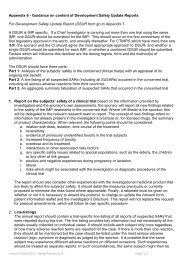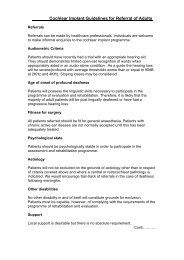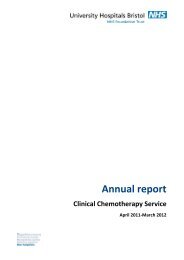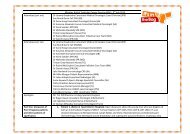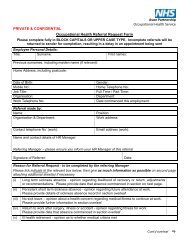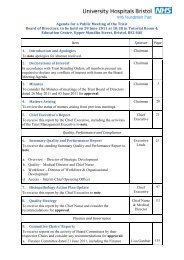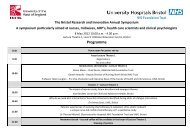Paediatric Cardiac Unit Annual Report 2009-10 - United Bristol ...
Paediatric Cardiac Unit Annual Report 2009-10 - United Bristol ...
Paediatric Cardiac Unit Annual Report 2009-10 - United Bristol ...
You also want an ePaper? Increase the reach of your titles
YUMPU automatically turns print PDFs into web optimized ePapers that Google loves.
6 <strong>Paediatric</strong> <strong>Cardiac</strong> <strong>Unit</strong> <strong>Annual</strong> <strong>Report</strong> <strong>2009</strong>-20<strong>10</strong>Pre-admission clinics: a further chance to askWhen a child is diagnosed asneeding cardiac interventionor surgery which is not acute,we make an appointment forhim or her to be admitted tohospital.Before they are admitted,we see the child in the preadmissionclinic.In recent years we have usedpre-admission clinics more andmore. They help patients andtheir families prepare for ahospital stay, and also help toreduce the child’s length of stayin hospital.At the clinics, patients are givena physical examination, chestradiograph, echocardiogramand screening blood tests toensure they are fit for surgeryand to assess whether theirclinical situation has changed inany way. The parents will alsohave the opportunity to meetthe team responsible for theirchild’s admission and discussevery aspect of their care.As the clinics are held at theChildren’s Hospital, it is oftenpossible for a child and hisor her parents to see wheretreatment and recoverywill take place, visiting thepaediatric cardiac ward, and the<strong>Paediatric</strong> Intensive Care <strong>Unit</strong>.Patients and parents can also‘visit’ theatre and the catheterlab via video, which gives thema virtual tour of our facilities.Pre-admission clinics help toreduce cancellations and thepossibility of families makingunnecessary travel or carearrangements. They alsogive the child and his or herfamily the chance to get theanswers to any questions theymay still have.Sue Simpson, cardiac physiologist service managerin the ECHO Suite
<strong>Paediatric</strong> <strong>Cardiac</strong> <strong>Unit</strong> <strong>Annual</strong> <strong>Report</strong> <strong>2009</strong>-20<strong>10</strong> 7In theatre: patient safety firstSurgeonsand nursesHaving reviewed thediagnostic data, thesurgeon carries out theoperation with the help ofthe assistant surgeon.The scrub nurse getseverything that will beneeded for the operationready and acts as the‘go-between’ betweenthe sterile surgical teamand the non-sterilesupport nurses.The scrub nursepasses the requiredinstruments andequipment to the surgeon.PerfusionistsThey control the heartlungbypass machinewhich keeps the patientalive while the heart isstopped for the operation.Two perfusionists arealways available forevery operation.AnaestheticteamThey put the patientto sleep and keepthem asleep duringthe operation.They also monitorand keep stable allphysiologic parametersin the patient during theoperation, and administerdrugs and blood products.Anaesthetists aresupported by highlytrainedanaesthetic nursesor operating departmentassistants.CardiologistsThey refer the patientsfor surgery and ensurethe correct information isavailable to the surgeonprior to the operation.They also attend inthe operating theatretowards the end of theoperation to performan echocardiogram toconfirm that the operationhas been successful andthat the heart isworking well.
<strong>10</strong> <strong>Paediatric</strong> <strong>Cardiac</strong> <strong>Unit</strong> <strong>Annual</strong> <strong>Report</strong> <strong>2009</strong>-20<strong>10</strong>PICU matron William Booth talks to a mother and patientThe <strong>Paediatric</strong> Intensive Care <strong>Unit</strong> (PICU)When a child is admitted in anemergency, or has just undergone surgeryor an intervention and requires theclosest possible monitoring and care,he or she will come to the <strong>Paediatric</strong>Intensive Care <strong>Unit</strong> (PICU).PICU is at the heart of the Children’sHospital, immediately next door to theoperating theatre, and at any time abouthalf of its 15 beds will be occupied bycardiac patients.A staff of 120 nurses, who undergo atleast 12 months of specialist training,provide constant care.As the only unit of its kind in the SouthWest, and the main resource for cardiacpatients from South Wales, PICU isa busy place – it treats about sevenchildren who have had elective cardiacsurgery in <strong>Bristol</strong> every week, as well asemergencies.It’s also the base for our retrieval service– the rapid response team which goesout to collect cardiac patients who needintensive care on their way to <strong>Bristol</strong>.Cleanliness and hygiene are obviously apriority, and PICU has had no recordedcases of MRSA bacteraemia or C.difficilein the last year. Clinical staff provide thevery highest standards of medical carewhile making it a safe and welcomingplace for parents and their children.William Booth, the unit’s matron, says:“For most families it will be the mosttraumatic and anxious time in their lives.They need to know that their child is notin pain or distress. We are very good atsymptom control, and my practice is towalk around the unit every day and talkto the parents about anything they areconcerned about. We want parents tobe here – children are children, and theirparents are the best people to look afterthem, with our support. ”
<strong>Paediatric</strong> <strong>Cardiac</strong> <strong>Unit</strong> <strong>Annual</strong> <strong>Report</strong> <strong>2009</strong>-20<strong>10</strong> 11Cardiology clinics: providing continuing careMost children we treat will not needinvasive interventions or surgery tomanage their heart conditions; otherswill receive successful procedures thatset them on course for a healthy life,out of hospital, as outpatients.Both groups, however, need regularcontact with our paediatric cardiologistsand specialist nursing staff to monitortheir condition, check their treatments,and advise on the lifestyle choices bestsuited to them.In most cases, children don’t need tocome to a children’s hospital for thiscontact – it is often least disruptive tofamily life if they see our specialists asnear to home as possible. This is whereour cardiology clinics come into theirown.Our cardiologists hold more than 15clinics per week, in <strong>Bristol</strong> and in ournetwork of peripheral clinics across theSouth West and, with our colleagues inCardiff, South and West Wales.The clinics are essential in bringingtogether patients, their families andclinicians, and ensuring that treatment– in particular for those who haveundergone major surgery – continues tomeet the requirements of the child.Dr Alison Hayes, consultantpaediatric cardiologist and leadfor echocardiographyRoom for families on the paediatric cardiac wardJudith HernandezLead nurse forcardiac services“Because we see some childrenfrom birth until they areapproaching 18, there arenurses here who know patientsfor many years. This reassureschildren and their families, whoreally appreciate the security of afamiliar environment.”Judith Hernandez is the cardiacunit manager, an experiencedpaediatric nurse now responsiblefor running the 16-bed <strong>Paediatric</strong><strong>Cardiac</strong> Ward – Ward 32 – in theChildren’s Hospital.Ward 32 is staffed by paediatriccardiac nurses and attended byevery specialist branch of thecardiac team. And because itis exclusively for children withcardiac conditions, the ward isadapted to suit families as far aspossible without compromisingcare. There is a bed next to everychild for a parent who wants tosleep on the ward; sometimes twoparents can stay, and rooms arealso available at nearby RonaldMcDonald House.A family room allows parents toprepare food and relax, whiletrained play specialists visitchildren who cannot leave theirbeds to use the play centre.Although many patients willcome for a short stay, childrenwho have had major surgerymay need care for ten days ormore. When receiving a plannedintervention or surgery, they willbe prepared on the ward by thefull team of clinicians involved intheir treatment. They will comeback to the ward after treatment– although many surgical patientswill require additional monitoringin PICU for the first 24 to 48 hours.“We try to reduce the timechildren spend in PICU. Whereverpossible, we like to bring childrenback onto the ward on the sameday after an intervention. Here,school and play can be brought tothem at their bedside.”Ward staff are trained to deliverclinical care to the higheststandards, but are also availableto deal with parents’ practicalconcerns about treatments,long-term health concerns, or thepracticalities of having a child inhospital. “I strongly encourageparents to speak to me or any ofthe other senior nurses wheneverthey have any questions. Everycase is different; we treat eachchild as an individual.”
12 <strong>Paediatric</strong> <strong>Cardiac</strong> <strong>Unit</strong> <strong>Annual</strong> <strong>Report</strong> <strong>2009</strong>-20<strong>10</strong>Growing up in theTrust’s familyMany years ago, children weretold almost nothing about theirheart conditions until theybecame ‘adults’ – at which pointthey had a complete change ofclinicians, hospital and status.Samantha’s storyGraduate Samantha is 22 and in the final stages ofteacher training. At <strong>10</strong> she was diagnosed with acondition that made her heart beat too quickly andshe was fitted with a pacemaker. Here, she tells thestory of her recovery.But times have changed andwe place great emphasis ongradually introducing childrenand teenagers to the natureof their condition, likely futurecare, and to the fact that they,not their parents, will assumeresponsibility for their health.The paediatric cardiac unitand the adult congenital heartdisease service work together tomake this transition as seamlessas possible.Dr Graham Stuart is a consultantcardiologist specialising incongenital heart disease. Heworks with children and adults– he fitted a 15-year-old withthe country’s first-ever lead-freedefibrillator earlier this year.“There are now more adults withcongenital heart disease thanchildren, and to give them thebest chances of living a full life,we need to gradually empowerteenagers and introduce them tothe issues around their condition.It is a process that can start ataround 12 or 13 and is largelya matter of how you talk tothe young people. Many of theboundaries between paediatricand adult services are, when itcomes to teenagers, artificial.“Most children with heart diseasewill require some sort of followuptreatment as adults. It maynot need to be frequent, but itwill need to be expert. One ofthe big benefits of <strong>Bristol</strong> is thiscan all happen on one campus.”“Throughout my childhoodI was a lively child;hyperactive was oftena word used to describeme. I used to get what Icalled ‘dizzy heads’ whereI would feel dizzy and seeflashing lights. I had sometests done on my brain andon one occasion an ECG,but there appeared to benothing wrong.“Then, when I was <strong>10</strong>, I was playingnetball in my garden and felt veryill, so I called my mum who noticedwhen glancing at my chest that myheart was beating very fast.“We went to the doctor who toldus to pop into hospital. We weren’texpecting to be there long; as faras we were concerned there wasn’tmuch wrong. After walking upSt Michael’s Hill, we arrived at thehospital and staff were waitingfor us; it was then that we realisedsomething was wrong.“I had atrial tachycardia andbecause I’d had it long term withno awareness, my heart was veryweak and enlarged. I went intointensive care, and while I washere I had some operations in anattempt to zap the node that wasmaking my heart beat too fast. Thestaff were lovely and entertaining,accompanying me in watching myfavourite TV programme, Friends,and having hat competitions!“While in intensive care my heartwent into cardiac arrest, which iswhen I had my pacemaker fitted.Due to the AV node being in adifficult location and myheart being so weak itneeded a quick fix, mypacemaker at this timecontrolled the bottom ofmy heart. When I cameout of hospital my heartslowly got better. I wentfor regular check-upsand went back to schoolstarting by doing half daysand increasing.“My family and I were so pleasedwhen we went for check-ups as itgot a little better each time. WhenI was 16, it was time to have mypacemaker changed as the batteryonly had a life of about six years.I had this operation in the newChildren’s Hospital, which was lovely.“As my heart was a lot better, thetop part of my heart was beating ata slower pace so the settings of mypacemaker were changed so that myheart mostly beats like a normal one;an electrical signal is sent from thetop chambers of my heart throughthe pacemaker to the bottom(that’s my understanding of it in myown language).“I had a few problems with mypacemaker after this operation. Ihad a lot of swelling around thearea which caused the wires of mypacemaker to move and rub againstmy skin, so I had one more operationin the Children’s Hospital, but thenhad to start going to the BHI. Buthaving been there twice now foroperations, I know it is no different –the staff are just as kind and helpful.And the check-ups are great, just tohear that everything is going OK.”
<strong>Paediatric</strong> <strong>Cardiac</strong> <strong>Unit</strong> <strong>Annual</strong> <strong>Report</strong> <strong>2009</strong>-20<strong>10</strong> 13Working with partners in <strong>Bristol</strong> and beyondIn recent years we have investedmore and more effort into buildingrelationships with other institutionsso that shared knowledge andexpertise can benefit our patientsand society at large.We are fortunate that we are at thecentre of the University Hospitals<strong>Bristol</strong> family, which, as the majorregional centre of medical research,is connected in turn to a widernetwork of research partners.The opening of the <strong>Bristol</strong> HeartInstitute (BHI) last year, as partof the Trust, has made <strong>Bristol</strong> aregional and national centre ofexcellence for clinical care andresearch into the treatment of heartdisease. As the <strong>Paediatric</strong> <strong>Cardiac</strong><strong>Unit</strong> is part of the <strong>Bristol</strong> CongenitalHeart Centre, we are part of thiswider family, alongside colleaguesin the Grown Up Congenital Heartunit (GUCH). The BHI buildingitself is around the corner from theChildren’s Hospital.Many of our clinicians conductresearch in conjunction with theBHI, and all of them benefit fromthe ground-breaking work beingcarried out in cardiac surgery,cardiology and anaesthesia.Surgeon Dr Massimo Caputo isa principal investigator in theBHI’s programme of research intopaediatric cardiac surgery.All of our surgeons and somecardiologists also treat adultpatients with congenital heartdisease there, creating a strongpersonal and professional link. Manyof the children we treat will go onto receive care as adults at the BHI.Few congenital heart diseasecentres in the country can offer anequivalent level of continuity ofcare between paediatric and adulttreatment in such close proximity.The BHI attracts world-classacademics undertaking basicscientific research – and we arealready translating this to care atthe bedside. The links betweenteaching, training, research andclinical care are strong throughoutthe Trust. In our own team, cliniciansboth teach and have studied atthe University of <strong>Bristol</strong> and theUniversity of the West of England.Biomedical Research <strong>Unit</strong>The Biomedical Research <strong>Unit</strong> (BRU)for cardiovascular disease, based atthe <strong>Bristol</strong> Heart Institute, is carryingout world-class research into heartdisease. Two of the six areas of itsresearch involve conditions thataffect children – congenital heartabnormalities, and paediatriccardiac surgery.Clinicians from our paediatriccardiac unit are closely involvedin both conducting this researchand translating its benefits to thechildren in our care. One exampleis the work of Professor Andy Wolf,consultant paediatric anaesthetist.His research into blood pressurecontrol at the BRU may lead tobetter understanding of – andways to treat – life-long high bloodpressure among patients born withabnormalities in the aorta.The BRU is a joint project betweenthe Trust and University of <strong>Bristol</strong>,and received £3.8m of Departmentof Health funding in 2008.<strong>Bristol</strong> MedicalSimulation CentreTraining in critical situations andclinical procedures has benefitedfrom our links to the <strong>Bristol</strong> MedicalSimulation Centre (BMSC), acrossthe road from us in the UniversityHospitals <strong>Bristol</strong> Education Centre.At the BMSC, the first centre ofits kind in the UK, critical eventsthat might be encountered inthe <strong>Paediatric</strong> Intensive Care <strong>Unit</strong>or in theatre can be rehearsedusing virtual models. Computercontrolledmanikins play the partof patients, while training staffconduct scenarios designed to testand improve clinicians’ reactions topressure and unexpected situations.The simulator is particularly valuablefor practising very rare events orunusual procedures, so cliniciansare prepared when a child’s healthis at risk.
14 <strong>Paediatric</strong> <strong>Cardiac</strong> <strong>Unit</strong> <strong>Annual</strong> <strong>Report</strong> <strong>2009</strong>-20<strong>10</strong>Our links with South and West WalesIn recent years we have built astrong partnership with a teamof four Consultant <strong>Paediatric</strong>Cardiologists at the UniversityHospital of Wales in Cardiff, whosee children with heart conditionsfrom across South Wales. In 2008/09,199 children were referred to us byconsultants in Wales for in-patienttreatment.In general, children from SouthWales who need cardiac surgery, acardiology intervention or cardiacintensive care, now come to us in<strong>Bristol</strong> for treatment.The relationship requires closecollaboration between our team,the patients’ local paediatrician, andour colleagues in Cardiff.Consultant paediatric cardiologistDr Dirk Wilson, who is clinicaldirector in Cardiff, says thepartnership means comprehensivecare can be offered to every patient.“We provide core cardiology carefor our patients, so we have a closelink with the team in <strong>Bristol</strong>. Whena child needs to have some formof intervention, we jointly agreethe treatment with the team in<strong>Bristol</strong> before the patient is formallyreferred. It requires very close“We provide corecardiology care for ourpatients, so we have aclose link with the teamin <strong>Bristol</strong>... It requiresvery close communicationbetween the two teams,and it is clinically effective.”Dr Dirk WilsonConsultant paediatric cardiologistcommunication between the twoteams, and it is clinically effective.The feedback from parents andpatients is that largely they arevery satisfied.”As a result of the collaboration,our links to South Wales havegrown. Last year, we receivedreferrals from 12 Welsh hospitals,with a geographical spreadextending from Withybush GeneralHospital in Haverfordwest,to Bronglais Hospital inAberystwyth, and Nevill HallHospital in Abergavenny.Leading our experts in South WalesOur intensive care retrievals servicecollects acute cases which needto be admitted to our <strong>Paediatric</strong>Intensive Care <strong>Unit</strong>, and our cardiacliaison nurses provide one of anumber of outreach and outpatientservices that extend throughoutthe region.Advances in telemedicine – whichallows consultations to be doneremotely between consultantsand patients in Cardiff or theirlocal District General Hospital, andconsultants here in <strong>Bristol</strong> – arelikely to see these links with SouthWales grow further.Dr Wilson was born in Ohioand moved to the UK aged11. He has a medical degreefrom University of WalesCollege of Medicine (1989),with an intercalated BScin physiology (1986). Hecompleted specialist trainingat the University Hospitalof Wales in Cardiff andJohns Hopkins University,Dr Dirk G WilsonConsultant <strong>Paediatric</strong> Cardiologist and Clinical Director,University Hospital of Wales in CardiffBaltimore, USA. Appointedas consultant paediatriccardiologist in Cardiff in1999, he oversaw servicereconfiguration with formalagreement to link with<strong>Bristol</strong> from 2001. Dr Wilsonhas been Clinical Director(Child Health) of UniversityHospital of Wales in Cardiffsince 2007 and DivisionalDirector (Children andWomen’s) since April 20<strong>10</strong>.Key clinical interests: Adultcongenital heart disease andMarfan syndrome.
<strong>Paediatric</strong> <strong>Cardiac</strong> <strong>Unit</strong> <strong>Annual</strong> <strong>Report</strong> <strong>2009</strong>-20<strong>10</strong> 15Leading our experts in <strong>Bristol</strong>Mr Andrew ParryConsultant Congenitaland Lead <strong>Cardiac</strong> SurgeonTrained at Oxford University andundertook basic surgical training in theSouth of England. Completed adultcardiac surgical training at the OxfordHeart Centre and Papworth Hospital in1995 then went to San Francisco for aspecialised congenital period of training,initially for a year. After this, was invitedto stay on for a year of research, duringwhich time was appointed to permanentrole of assistant professor in 1997. In1999, returned to UK to take up a postin <strong>Bristol</strong>. Mr Parry is now the seniorsurgeon.Key clinical interests: Neonatal cardiacsurgery, management of patientswith hypoplastic left heart syndrome,adult congenital cardiac surgery, anddifficult pacing problems. Undertookresearch leading to Doctor of Medicinethesis into prospects for foetal cardiacsurgery. Current research interestsare the physiology of single ventriclecirculations, brain injury associated withcardiac surgery, and the use of new andnovel technology in the management ofpatients with congenital cardiac disease.Dr Andrew TometzkiConsultant <strong>Paediatric</strong> and Foetal Cardiologist andLead for <strong>Cardiac</strong> ServicesQualified at Sheffield University in 1985, trainedinitially in paediatrics before concentrating onpaediatric cardiology at Liverpool, Edinburghand San Francisco. Dr Tometzki moved to the<strong>Bristol</strong> Royal Hospital for Children in July 1999.He has a particular interest in interventionalcardiology and foetal cardiology. He set up the <strong>Bristol</strong>Children’s telemedicine Service to allow remote foetal andpaediatric cardiac diagnosis, counselling, multi-disciplinarymeetings, as well as remote teaching of doctors, nurses andtechnicians.Key clinical interests: Interventional cardiology, Foetalcardiology and telemedicine.Dr Peter DavisConsultant <strong>Paediatric</strong> Intensivist andLead Clinician <strong>Paediatric</strong> Critical CareTrained in paediatrics in Cardiff, Birminghamand Leicester. First trained in paediatricintensive care and retrieval medicine atLeicester Royal Infirmary, followed by trainingat Birmingham Children’s Hospital, GlenfieldHospital in Leicester as an ECMO fellow, BritishColumbia’s Children’s Hospital in Vancouver, Great OrmondStreet Hospital, and as chief registrar at the Royal Children’sHospital in Melbourne. Appointed as a consultant in <strong>Bristol</strong> in2003 and became director of PICU in 2007.Key clinical interests: <strong>Paediatric</strong> critical care epidemiology andorganisation (member of PICANet Clinical Advisory Group andmedical lead of South West Audit of Critically Ill Children).Chapter XB Expert Working Group member developing the<strong>Paediatric</strong> Critical Care Minimum Data Set.Dr Mark TurnerConsultant and Lead for Grown-Up Congenital Heart DiseaseTrained in Medicine at the University of<strong>Bristol</strong> and graduated with Honours in1990. Served in the Royal Navy, where hetrained in diving medicine as well as beinga submarine escape instructor and ship’sdiving officer, before training in generalmedicine. Between 1996 and 2005 he trainedin cardiology in Plymouth, Cardiff, GreatOrmond Street Hospital and at UniversityCollege London Hospitals. He completed aDoctorate of Philosophy at Cardiff Universityin 2004 and was appointed as a consultantin <strong>Bristol</strong> in 2005. He is a member of the UKSports Diving Medical Committee and anApproved Medical Examiner for ProfessionalDivers.Key clinical interests: Congenital andstructural heart interventions, pacemakertherapy (especially cardiac resynchronisation)and diving medicine, particularly withrespect to patent foramen ovale.
16 <strong>Paediatric</strong> <strong>Cardiac</strong> <strong>Unit</strong> <strong>Annual</strong> <strong>Report</strong> <strong>2009</strong>-20<strong>10</strong>Looking to the futureTechnology: the hybrid labThe <strong>Bristol</strong> Heart Institute’snew hybrid lab is one of thefirst in the country to allowcardiologists and surgeonsto combine procedures thatwould normally be separatedbetween a catheter lab andan operating theatre.The lab contains advancedradiographical and otherimaging equipment, whichwill support image-guidedinterventions like valveinsertions from the groin,as well as a conventionaloperating table. By allowingmultiple procedures tobe carried out under thesame anaesthetic, thelab minimises the time apatient spends in theatreand the number of hospitaladmissions they have.The <strong>Bristol</strong> Heart Institute atriumResearch: open heart surgeryWhen children undergo open heartsurgery to repair heart conditions orabnormalities that starve the bodyof oxygen, there is a danger theirorgans and brain could be damagedwhen they begin to receive theiroxygen from a life-support machine.Research* carried out by our unitin conjunction with the <strong>Bristol</strong>Heart Institute last year found thatby limiting the amount of oxygenthe child receives initially duringsurgery, the damage is reduced.The technique is likely to beadopted worldwide.Our clinicians have built a traditionof research work, both with theUniversity of <strong>Bristol</strong> and withacademic and commercial researchestablishments across the UK. Ourteam is currently working on 19major research projects.New techniques: surgery for hypoplastic left heart syndromeThe hearts of children born with hypoplastic leftheart syndrome (HLHS) have underdeveloped left sidechambers and blood vessels, which means blood cannotbe pumped directly into the aorta and around the body.Untreated, sadly the condition is fatal.Treating HLHS requires a series of intricate operations,considered among the most technically complexprocedures in cardiac surgery.The first stage, the Norwood procedure, involvesconnecting the aorta to the right ventricle of theheart; a shunt is required so that blood continues toflow to the lungs. Last year, after a nearly a decade ofpreparation and research, our unit began to carry outthis procedure, with excellent results.We successfully performed seven of these procedures,with all of these babies discharged home well.
<strong>Paediatric</strong> <strong>Cardiac</strong> <strong>Unit</strong> <strong>Annual</strong> <strong>Report</strong> <strong>2009</strong>-20<strong>10</strong> 17Data report: April 2007 – March 20<strong>10</strong>INTRODUCTIONThis report presents in detail the activity and results of the congenital cardiac surgical service for the financial years2007-20<strong>10</strong>. All data for the current year (<strong>2009</strong>-20<strong>10</strong>) has been internally validated and submitted to the Central<strong>Cardiac</strong> Audit Database (CCAD) www.ccad.org.uk who will be validating the data independently throughout thenext calendar year. In previous years, the internal validation of the data presented within this report has beenverified by CCAD.SURGICAL ACTIVITYIn the past three years, April 2007 to March 20<strong>10</strong>, the number of operations performed has increased year on year,from 354 to 387 (an increase of 9.32%). The breakdown in activity by patient age and year is as shown in Figure 1.Patients aged under 16 years were treated in the <strong>Bristol</strong> Royal Hospital for Children. All patients aged over 17 yearswere admitted to <strong>Bristol</strong> Royal Infirmary (BRI), or the new <strong>Bristol</strong> Heart Institute (BHI) from May <strong>2009</strong>. Between theages of 16 and 17, depending on family/patient preference and appropriateness of the care environment, patientswere managed at either the Children’s Hospital or BRI/BHI.Figure 1.Of these operations, 859 were open, meaning the heart-lung bypass machine was required to perform them,and 250 were closed, not requiring the use of the heart-lung bypass machine (Figure 2). Most of the closed cases(85.2%) were performed in children aged under one. During this period, the proportion of closed cases performedfell from 27% to 19% overall, and from 42% to 31% in children aged under one. This reflects our move away froma policy of staged palliation to primary repair in children with a two-ventricle circulation.
18 <strong>Paediatric</strong> <strong>Cardiac</strong> <strong>Unit</strong> <strong>Annual</strong> <strong>Report</strong> <strong>2009</strong>-20<strong>10</strong>Figure 2.DEMOGRAPHIC DATAOf the patients treated, 50.9% were male and 49.1% female. 38.14% of patients had a Welsh postcode.RISK STRATIFICATIONOperative risk is dependent on many factors. These include urgency of surgery (operative priority), age and size atthe time of operation, pre-operative status, the number of previous operations, the complexity of the underlyingcardiac anomaly, and the procedure being performed. These risk factors are considered individually and data fromthe current year has been compared with the previous years’ data. Direct comparison with other UK centres is notpossible within this timeframe due to the limited data available. The most robust data available comes from theCentral <strong>Cardiac</strong> Audit Database (CCAD) initiative since all the data is independently validated. However, there is atime lag due to the process of validation and currently only data up to 2006-2007 is available.When comparing figures from a single institution with national data, care must be exercised due to the potentialfor bias (in either population or institution) in the frequency and management of high-risk patients which mayskew a surgeon’s or institution’s results. This is of particular relevance in the neonatal group, where the mostcomplex and difficult patients require surgical management. In order to obtain meaningful comparisons withnational data, we have reviewed those surgical procedures undertaken frequently where the patient populationrequiring treatment is relatively uniform and clear national comparative data are available.OPERATIVE PRIORITYOperative priority was categorised according to accepted definitions. The bulk of the workload for each year iselective, with 36-45% of all procedures being urgent or emergency operations and 55-64% elective (Table 1).Table 1. Priority of procedure all ages (2007 to 20<strong>10</strong>)2007-2008 2008-<strong>2009</strong> <strong>2009</strong>-20<strong>10</strong>No. Cases % Total No. Cases % Total No. Cases % TotalUnder 16 yearsElective 142 49.48% 147 52.31% 165 57.29%Urgent 133 46.34% 124 44.13% <strong>10</strong>6 36.81%Emergency 12 4.18% <strong>10</strong> 3.56% 17 5.90%Under 16 years total 287 281 288
<strong>Paediatric</strong> <strong>Cardiac</strong> <strong>Unit</strong> <strong>Annual</strong> <strong>Report</strong> <strong>2009</strong>-20<strong>10</strong> 192007-2008 2008-<strong>2009</strong> <strong>2009</strong>-20<strong>10</strong>No. Cases % Total No. Cases % Total No. Cases % TotalOver 16 yearsElective 54 80.60% 79 90.80% 84 84.85%Urgent 11 16.42% 6 6.90% 13 13.13%Emergency 2 2.99% 2 2.30% 2 2.02%Over 16 years total 67 87 99AGE VERSUS OPERATIVE PRIORITYWithin the population of patients with congenital heart disease requiring surgery we continue to see a significantdifference between age groups in the balance of elective to urgent or emergency cases (Table 2). The majority ofprocedures undertaken in neonates are urgent, whereas the majority of procedures undertaken in children agedover one year or in the adult population are elective. This reflects the fact that children with complex congenitalcardiac disease and/or duct dependent circulation present early in life. For some infants, irreversible changes canoccur early in the heart and lungs, even within the first few weeks or months of life, and surgery must therefore beundertaken promptly.Table 2. Priority of case load by age and category2007-08Elective Urgent EmergencyAge category No. cases % Age No. cases % Age No. cases % AgeNeonate 1 1.67% 56 93.33% 3 5.00%Infant 54 41.54% 69 53.08% 7 5.38%Child 87 89.69% 8 8.25% 2 2.06%16+ 54 80.60% 11 16.42% 2 2.99%Total cases 196 55.37% 144 40.68% 14 3.95%2008-09Elective Urgent EmergencyAge category No. cases % Age No. cases % Age No. cases % AgeNeonate 2 3.77% 48 90.57% 3 5.66%Infant 50 42.02% 64 53.78% 5 4.20%Child 95 87.16% 12 11.01% 2 1.83%16+ 79 90.80% 6 6.90% 2 2.30%Total cases 226 61.41% 130 35.33% 12 3.26%<strong>2009</strong>-<strong>10</strong>Elective Urgent EmergencyAge category No. cases % Age No. cases % Age No. cases % AgeNeonate 8 <strong>10</strong>.67% 59 78.67% 8 <strong>10</strong>.67%Infant 75 61.48% 41 33.61% 6 4.92%Child 82 90.11% 6 6.59% 3 3.30%16+ 84 84.85% 13 13.13% 2 2.02%Total cases 249 64.34% 119 30.75% 19 4.91%
20 <strong>Paediatric</strong> <strong>Cardiac</strong> <strong>Unit</strong> <strong>Annual</strong> <strong>Report</strong> <strong>2009</strong>-20<strong>10</strong>NUMBER OF OPERATIONS — INCLUDING CURRENT PROCEDUREIn the under one year age group over this time, 15% had previously undergone surgery (Figure 3); this is consistentwith our results for previous years. Most of those patients who underwent more than one operation were on apathway of staged palliation for their cardiac problem. It is our policy to perform second stage palliation for singleventricle defects at four to six months of age, and complete correction for two ventricle morphologies at six toeight months of age. For children aged between one and 16 years, 27% had previously undergone at least onecardiac surgical procedure (Figure 4).Figure 3.Figure 4.SURGICAL OUTCOMESince priority of the procedure, the complexity of surgery, and the number of previous operations have previouslybeen shown to be independent predictors of outcome after surgical procedures, surgical outcome is presentedbelow with these considerations. All data relate to the initial operative procedure performed; for patientsrequiring re-operation for a residual lesion during the same hospital stay, outcome is attributed to the primaryprocedure. This is the same premise on which the Central <strong>Cardiac</strong> Audit Database (CCAD) reporting is based anddata should therefore accurately refiect the risk of surgery for any particular congenital cardiac lesion – visitwww.ccad.org.uk/congenital for more information. In this section, deaths are recorded if they occurred within 30days of surgery or during the primary hospital stay, whichever is the shorter.
<strong>Paediatric</strong> <strong>Cardiac</strong> <strong>Unit</strong> <strong>Annual</strong> <strong>Report</strong> <strong>2009</strong>-20<strong>10</strong> 21MORTALITY VERSUS PRIORITY OF PROCEDUREAny operation which is necessary as an urgent or emergency procedure is associated with an increased risk as thereis less time available to stabilise the child, and the deleterious effects of the defect cannot be completely alleviatedbefore intervention is required. The more urgent the surgery, the sicker the child is and the less time is available toprepare the child for surgery. This is refiected in the outcomes. Overall mortality for the years 2007-20<strong>10</strong> was 1.2%for elective cases, 1.3% for urgent cases, and 6.7% for emergency cases (Table 3).Table 3. Mortality by priority of procedure all ages (2007-<strong>10</strong>)Age group Priority No. of cases No. deaths % MortalityUnder 1 year Elective 190 3 1.6%Urgent 337 4 1.2%Emergency 32 2 6.3%Under 1 year total 559 9 1.6%1-15 years Elective 264 1 0.4%Urgent 26 1 3.8%Emergency 7 1 14.3%1-15 years total 297 3 1.0%16+ years Elective 217 4 1.8%Urgent 30 0 0%Emergency 6 0 0%16+ years total 253 4 1.6%Total overall 1<strong>10</strong>9 16 1.4%MORTALITY VERSUS COMPLEXITY OF SURGERYOperations for congenital heart disease are divided into ‘closed’ (those not requiring the use of a heart-lungbypass machine) and ‘open’ (those requiring bypass) operations. ‘Open’ cases are further divided into ‘simple’ or‘complex’. More complex surgery is associated with increased risk (Table 4).Table 4. Mortality by operation type all ages (2007-<strong>10</strong>)Year Operation type No. cases No. deaths % mortality2007-2008Closed 96 4 4.2%Open/Simple 67 0 0.0%Open/Complex 191 3 1.6%2007-2008 total 354 7 2.0%2008-<strong>2009</strong>Closed 80 0 0.0%Open/Simple <strong>10</strong>2 0 0.0%Open/Complex 186 3 1.6%2008-<strong>2009</strong> total 368 3 0.8%<strong>2009</strong>-20<strong>10</strong>Closed 74 1 1.4%Open/Simple 126 2 1.6%Open/Complex 187 3 1.6%<strong>2009</strong>-20<strong>10</strong> total 387 6 1.6%
22 <strong>Paediatric</strong> <strong>Cardiac</strong> <strong>Unit</strong> <strong>Annual</strong> <strong>Report</strong> <strong>2009</strong>-20<strong>10</strong>As demonstrated below (Table 5) the majority of open heart procedures in neonates were not only urgent, butalso complex.Table 5. Age and type of operation (2007-<strong>10</strong>)Closedno. casesNo. deathswithin30 daysOpen/ComplexNo. deathswithin30 daysOpen/SimpleNo. deathswithin30 daysNeonate 91 1 82 2 15 0Elective 4 0 6 0 1 0Urgent 78 1 72 2 13 0Emergency 9 0 4 0 1 0Infant 122 2 146 2 <strong>10</strong>3 2Elective 19 1 85 1 75 1Urgent 97 1 54 0 23 0Emergency 6 0 7 1 5 1Child 27 1 158 2 112 0Elective 17 0 140 1 <strong>10</strong>7 0Urgent <strong>10</strong> 1 15 0 1 0Emergency 3 1 4 016+ <strong>10</strong> 1 178 3 65 0Elective 7 1 153 3 57 0Urgent 2 0 21 0 7 0Emergency 1 0 4 0 1 0Total overall 250 5 564 9 295 2MORTALITY VERSUS NUMBER OF OPERATIONS INCLUDING CURRENT PROCEDUREAs indicated previously, many patients with congenital heart disease will require multiple cardiac surgicalprocedures. Due to the normal healing process, scar tissue forms around the heart which must be dissectedthrough at all further operations; the greater the number of operations the thicker the scar tissue. The risk ofsubsequent operations is therefore likely to increase. Further, those patients requiring multiple cardiac surgicalprocedures are usually those with more complex anomalies. Previous cardiac surgery is therefore recognised asbeing associated with an increased risk for subsequent procedures. From our own data the only single year whichfulfils this prediction is <strong>2009</strong>-20<strong>10</strong>, while from the overall data for the three years the mortality for first, second,and third operations is 1.29%, 2.39%, and 1.07% respectively (Table 6).Table 6. Mortality by number of operations – open and closed (all ages)Year Operations performed No. cases No. deaths % mortality2007-20081 Operation 261 6 2.3%2 Operations 60 1 1.7%3+ Operations 33 0 0.0%2008-<strong>2009</strong>1 Operation 282 1 0.4%2 Operations 53 2 3.8%3+ Operations 33 0 0.0%<strong>2009</strong>-20<strong>10</strong>1 Operation 306 4 1.3%2 Operations 54 1 1.9%3+ Operations 27 1 3.7%
<strong>Paediatric</strong> <strong>Cardiac</strong> <strong>Unit</strong> <strong>Annual</strong> <strong>Report</strong> <strong>2009</strong>-20<strong>10</strong> 23POST-OPERATIVE RECOVERY AND HOSPITAL STAYThe duration of intensive care required following cardiac surgery depends on the severity of the heart disease(and therefore also the complexity of the surgery performed) and the pre-operative status of the child. As could bepredicted from this, the neonatal group had the longest <strong>Paediatric</strong> Intensive Care <strong>Unit</strong> (PICU) stay with a medianpost-operative stay of three days, compared to two days for infants and one day for children (Figure 5).Figure 5.SURGICAL DATA – CASE MIX AND PATIENT SELECTIONAs patients and parents strive to ensure that their surgery or that of their child is performed only in a centre wherethe results are good, it is not uncommon for results from different surgical units to be compared. This exercisemust, however, be undertaken with great care due to inherent bias potentially present within the data. The primefactors in this consideration are case mix and patient selection. If coarse data were simply compared withoutappreciating the complexity of the case mix, a very biased conclusion could be reached: a centre doing only lowriskprocedures would appear to be performing better than one in which all procedures, including very high-risk
24 <strong>Paediatric</strong> <strong>Cardiac</strong> <strong>Unit</strong> <strong>Annual</strong> <strong>Report</strong> <strong>2009</strong>-20<strong>10</strong>cases, were being treated. Similarly, for two centres offering the same surgical procedures, if one centre refusedto treat patients considered to be ‘high risk’, this centre would appear ‘better’ than the other in which all patientsunderwent surgery.The identification of national ‘benchmark’ procedures has been an attempt to minimise confounding factorsand to allow fairer comparison between centres. However, the type and number of procedures identified as‘benchmark procedures’ are limited and make up less than 50% of the surgical workload. In Table 7 we reportcategories of congenital cardiac surgical procedures which are undertaken in sufficient number with a patientprofile of predictable complexity to allow reasonable comparison. In order for further comparison of overallmortality data with other units to be valid we need to address any potential concerns that our cases are somehowless complex or different from other centres. Over the last year, after <strong>10</strong> years of preparation and training, westarted a programme for the surgical treatment of patients with hypoplastic left heart syndrome. Therefore,we now offer surgery for every congenital heart defect. The results we publish reflect our experience with allthese children. Further, all children, except those with co-existent, lethal, extra-cardiac abnormalities, are offeredtreatment in our unit.BENCHMARK PROCEDURESIn 1998 the Society of Cardiothoracic Surgeons of Britain and Ireland proposed that an individual surgeon’sperformance should be continually monitored through selected ‘benchmark’ procedures. Six were identified:ASD closure, VSD closure, repair of complete AV septal defect, correction of Tetralogy of Fallot, arterial switchprocedure in ‘simple’ transposition and repair of coarctation. Data for our unit for these common benchmarkprocedures and other common abnormalities are presented in Table 7. The death following PDA ligation in 2007-2008 was in a very premature infant who recovered from the operation but died of complications of prematurity.Table 7. Benchmark procedures2007-2008 2008-<strong>2009</strong> <strong>2009</strong>-20<strong>10</strong>cases Deaths cases Deaths cases DeathsClosed heart proceduresCoA 34 0 21 0 26 0PDA 22 1 30 0 27 0Closed heart procedures total 56 1 51 0 53 0Open heart proceduresASD 27 0 35 0 30 0ASO 23 0 21 0 13 0CAVSD 11 0 <strong>10</strong> 0 11 0Fallot 20 0 25 0 25 0Fontan <strong>10</strong> 1 5 0 5 0Norwood 7 0PAVSD 5 0 12 0 9 0Truncus 1 0 3 0 2 0VSD 41 0 37 0 43 0Open heart procedures total 138 1 148 0 145 0Grand total 194 2 199 0 198 0Key of abbreviations:CoA Repair of aortic coarctation PDA Ligation of persistent ductus arteriosusASD Closure of atrial septal defect ASO Arterial switch operationCAVSD Repair of complete AV septal defect Fallot Repair of Tetralogy of FallotPAVSD Repair of partial AV septal defect Truncus Repair of truncus arteriosusVSDClosure of ventricular septal defectAcknowledgementsWith thanks to José Velázquez, information and data manager, and Mike Wakelam, information analyst, at <strong>Bristol</strong> Royal Hospital for Childrenfor their efforts in assisting with data acquisition, data analysis and the preparation of this report.
“This report demonstrates that <strong>Bristol</strong> continues to meet the challenges of new and innovativetechniques in congenital heart surgery. These results are testimony to the dedication of thewhole clinical network, from early and accurate diagnosis to the necessary teamwork in thetheatre and intensive care arenas, as well as the support following discharge home by ourcolleagues in Cardiff and the peripheral hospitals in the South West and South Wales.”Mr Andrew ParryLead Consultant <strong>Paediatric</strong> <strong>Cardiac</strong> Surgeon, <strong>Bristol</strong> Royal Hospital for ChildrenJune 20<strong>10</strong>The paediatric cardiac team – nurses, AHPs, doctors and surgeons – in the Children’s Hospital outdoor play areaIf you would like this report in any other language or format, pleasecontact:Communications DepartmentUniversity Hospitals <strong>Bristol</strong> NHS Foundation TrustTrust HeadquartersMarlborough Street<strong>Bristol</strong>BS1 3NUTel: 0117 342 3620A copy of the data report April 2007–March 20<strong>10</strong> is available to view or download on ourwebsite, www.uhbristol.nhs.uk, under ‘Key Publications’.
Through our patients’ eyes...


